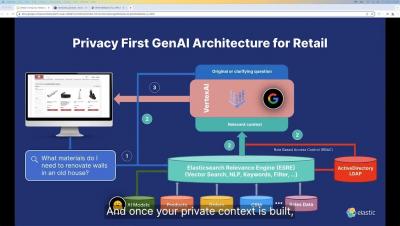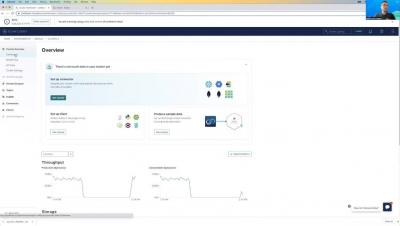Operations | Monitoring | ITSM | DevOps | Cloud
July 2023
Turning Your Retail eCommerce into a Platform of Engagement and Loyalty
Up to 70% metrics storage savings with TSDS enabled integrations in Elastic Observability
The latest versions of Elastic Observability’s most popular observability integrations now use the storage cost-efficient time series index mode for metrics by default. Kubernetes, Nginx, System, AWS, Azure, RabbitMQ, Redis, and more popular Elastic Observability integrations are time series data stream (TSDS) enabled integrations.
Elastic Search 8.9: Hybrid search with RRF, faster vector search, and public-facing search endpoints
Elastic Search 8.9 introduces hybrid search with Reciprocal Rank Fusion (RRF) to combine vector, keyword, and semantic techniques for better results. This release also brings performance improvements in vector search and ingestion with response times that are up to 30%+ faster. Users also have more ingestion options with the new SharePoint Online connector, which includes document-level security.
Creating an environment for distributed teams to thrive and innovate
Understanding APM: How to add extensions to the OpenTelemetry Java Agent
As an SRE, have you ever had a situation where you were working on an application that was written with non-standard frameworks, or you wanted to get some interesting business data from an application (number of orders processed for example) but you didn’t have access to the source code?
Turning data into mission value in government and education
Government and education leaders estimate that data volume at their organizations will increase by 59% over the next three years. Although having more information than you need is (arguably) better than not having it when you need it, the sheer volume of data can make it challenging for teams to pinpoint exactly what data will bring value to their mission goals.
What is an Elasticsearch index?
The term index is quite overloaded in the tech world. If you asked most developers what an index is, they might tell you it commonly refers to a data structure in a relational database (RDBMS) that is associated with a table, which improves the speed of data retrieval operations. But what is an Elasticsearch® index?
The hidden data challenges CIOs face on their quest to accelerate business outcomes
Navigating the complex terrain of IT systems, operational issues, and security breaches is no easy job, even for the seasoned CIO. And when tasked with the lofty goals of improving operational resilience, mitigating security risk, and enhancing customer experiences, dealing with the day-to-day operations is all the more challenging. Achieving these goals can often feel overwhelming, with no end to the journey in sight.
How to combine OpenTelemetry instrumentation with Elastic APM Agent features
Elastic APM supports OpenTelemetry on multiple levels. One easy-to understand scenario, which we previously blogged about, is the direct OpenTelemetry Protocol (OTLP) support in APM Server. This means that you can connect any OpenTelemetry agent to an Elastic APM Server and the APM Server will happily take that data, ingest it into Elasticsearch®, and you can view that OpenTelemetry data in the APM app in Kibana®.
Index data into Elastic Cloud from Confluent Cloud
Exploring Nginx metrics with Elastic time series data streams
Elasticsearch® recently released time series data streams for metrics. This not only provides better metrics support in Elastic Observability, but it also helps reduce storage costs. We discussed this in a previous blog. In this blog, we dive into how to enable and use time series data streams by reviewing what a time series metrics document is and the mapping used for enabling time series. In particular, we will showcase this by using Elastic Observability’s Nginx integration.
How to capture custom metrics without app code changes using the Java Agent Plugin
The Elastic APM Java Agent automatically tracks many metrics, including those that are generated through Micrometer or the OpenTelemetry Metrics API. So if your application (or the libraries it includes) already exposes metrics from one of those APIs, installing the Elastic APM Java Agent is the only step required to capture them. You'll be able to visualize and configure thresholds, alerts, and anomaly detection — and anything else you want to use them for!
Unlocking valuable healthcare data to improve patient outcomes and reduce clinical risk with Elastic
Accelerating R&D in pharma with Elasticsearch, ESRE, LLMs, and LangChain - Part 1
A comprehensive guide to support faster drug innovation and discovery in the pharmaceutical industry with generative AI/LLMs, custom models, and the Elasticsearch Relevance Engine (ESRE) Faster drug discovery leading to promising drug candidates is the main objective of the pharmaceutical industry. To support that goal, the industry has to find better ways to utilize both public and proprietary data — at speed and in a safe way.
Making the boat faster: Advantages of embedding services and training in software sales
In the highly competitive IT industry, staying ahead of the curve is crucial for success. As IT companies strive to meet the evolving needs of their customers, they are discovering that providing embedded services and comprehensive training can significantly enhance their sales efforts. The importance of having services is discussed in this Harvard Business Review article.
Vector search in Elasticsearch: The rationale behind the design
Are you interested to learn about the characteristics of Elasticsearch for vector search and what the design looks like? As always, design decisions come with pros and cons. This blog aims to break down how we chose to build vector search in Elasticsearch.
How to get the best of lexical and AI-powered search with Elastic's vector database
Maybe you came across the term “vector database” and are wondering whether it’s the new kid on the block of data retrieval systems. Maybe you are confused by conflicting claims about vector databases. The truth is, the approach used by vector databases has been around for a few years.



















